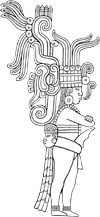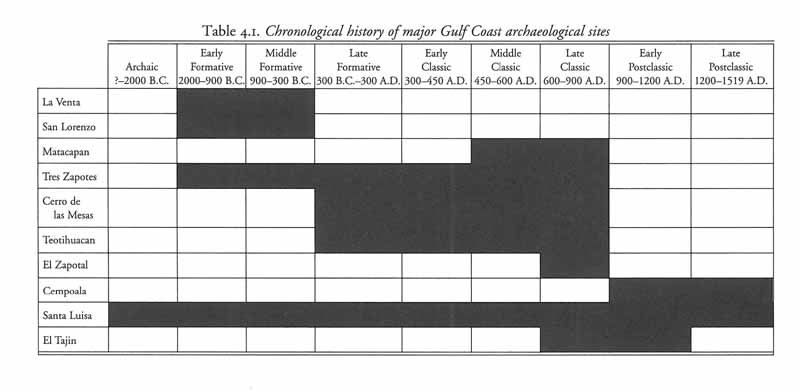

|
Death Gods, Smiling Faces and Colossal Heads: Archaeology of the Mexican Gulf Lowlands by Richard Diehl |
|
| |
Archaeological investigations in the Gulf Coast lowlands have revealed some of ancient America's most spectacular remains. However, the intensive research necessary to achieve a real understanding of ancient cultures and the processes that account for their history has been largely absent in the region until recently. Instead, most research has emphasized recovery of sculptures, restoration of ancient buildings, and the construction of ceramic chronologies. The most intensively studied and best-known sites include La Venta, San Lorenzo, Tres Zapotes, Matacapan, Cerro de las Mesas, El Zapotal, Las Higueras, Remojadas, Cempoala, and El Tajin. The magnitude of our ignorance can be measured by the fact that thirty years ago the archaeological site files at the University of Veracruz contained references to more than six hundred large sites in central Veracruz and adjacent Puebla alone, a relatively small portion of the total Gulf Coast lowland region. In recent decades archaeologists have begun to address well-formulated research problems through long-term field projects designed to study entire sites and regions. La Venta, San Lorenzo Tenochtitlan, Matacapan and its Tenochtitlan, Matacapan and its Tuxtla mountain hinterland, the Mixtequilla, Santa Luisa and the lower Tecolutla River zone, El Tajin, and the Tamuin and Rio Verde regions of San Luis Potosi all have been investigated by recent projects of this sort. Much of this research has yet to be published or is available only in preliminary form, therefore our understanding of the region's prehistory may change significantly as new data and interpretations appear. With a few notable exceptions, the Gulf Coast archaeological chronologies are notoriously sketchy and poorly documented. This chapter employs the generalized Mesoamerican chronological framework used by most investigators, with the caveat that many placements depend more on faith and accepted wisdom than on archaeologically verified information (Table 4.1, Chronology Chart). This generalized cultural sequence is divided into eight time periods: the Paleoindian and Archaic (?-2ooo B.C.), Early Formative (2000-900 B.C.), Middle Formative (900-300 B.C.), Late Formative (300 B.C.-A.D. 300), Early-Middle Classic (A.D. 300-600), Late Classic (A.D. 600-900), Early Postclassic (A.D. 900-1200), and Late Postclassic (A.D. 1200-1519).
By the end of the third millennium B.C. small, scattered groups of foragers and incipient agriculturalists occupied most if not all of the region. Very little is known about these groups because their remains have not attracted much interest on the part of archaeologists, but it is safe to assume that they provided the biological and cultural foundations for the later cultures of the region. La Conchita and Santa Luisa, two Palo Hueco-phase (ca. 2900 B.C.) sites near the mouth of the Rio Tecolutla on the north-central Gulf Coast, are indicative of what future investigators should find elsewhere. The inhabitants collected oysters, clams, mussels, and other shellfish; fished; caught land crabs; and hunted locally available land mammals. They surely collected wild plants and may have cultivated a few domesticated species, although no botanical remains have been recovered. The excavator, S. J. K. Wilkerson (1975), has suggested that Santa Luisa was a permanent village rather than a seasonal campsite. Although the inhabitants were basically self-sufficient, they did import obsidian from the El Paraiso source in Queretaro 330 kilometers to the west. The oldest known remains of permanent villages occupied by farmers who cultivated maize are the Early and Middle Barí-phase sites (2.250-1400 B.C.) near the later Olmec center of La Venta, Tabasco. According to W. F. Rust and R. J. Sharer (1988), Bari villagers constructed round and rectangular houses with wattle-and-daub walls, packed-earth floors, thatched roofs, and subterranean storage pits. The small villages occupied the same rich, easily worked river levees where their inhabitants planted crops. Ban trash deposits suggest a varied and plentiful diet that included maize (Zea mays), palm nuts, mollusks, fish, turtles, crocodilians, deer, armadillos, racoons, and the ubiquitous domesticated dog, Canis familiaris. They also contain grit-tempered pottery with brushed surfaces, basalt grinding tools for processing maize and possibly palm nuts, and obsidian tools. Similar remains occur in the Ojochi phase (1500-1350 B.C.), the earliest occupation at the Olmec center of San Lorenzo in the Rio Coatzacoalcoas basin, and in the Raudal and Almeria phases (1700-1350 B.C.) at the Santa Luisa site on the banks of the Rio Tecolutla. The pottery found at these sites is quite similar in form, decoration, method of manufacture, and, presumably, function. Furthermore, it bears striking resemblances to pottery from Pacific Coast lowlands of Chiapas and Guatemala just across the low-lying Isthmus of Tehuantepec. Most archaeologists believe that the idea of pottery originated in lowland coastal Ecuador and Colombia and later diffused to Central America and southern Mesoamerica via the Pacific Coast (D. Grove 1992). Early Pacific and Gulf Coast vessel forms include jars, shallow bowls, and tecomates (rimless jars with restricted mouths, which may have been used to cook maize). None of the remains just discussed suggest the existence of social hierarchies, pronounced economic differences between families or communities, or political power concentrated in the hands of a few people. Thus it is safe to infer that these societies were basically egalitarian groups of the type anthropologists call tribes. However, inequalities of wealth and status came into existence at San Lorenzo, La Venta, and elsewhere in the southern Veracruz – Tabasco region when what archaeologists call Olmec culture or civilization made its first appearance after 1500 B.C. |
|
|
Text links to all pages at this site are available at the FAMSI INDEX |
||
